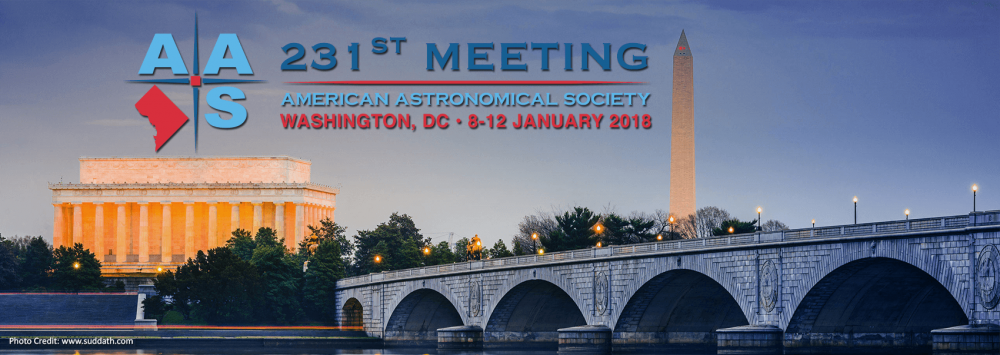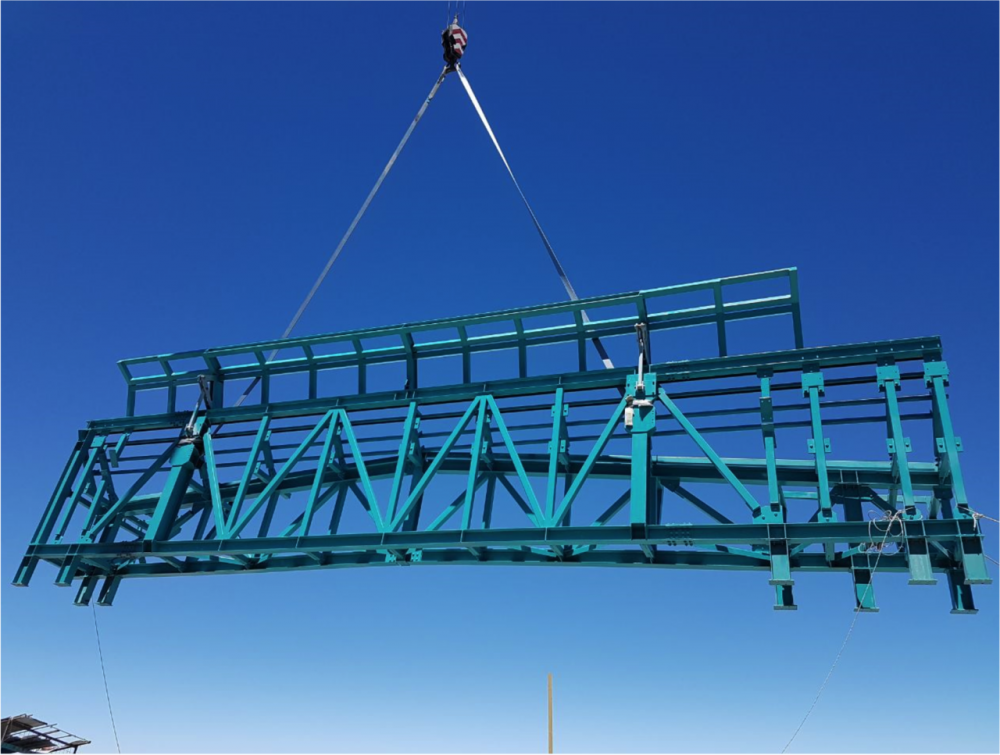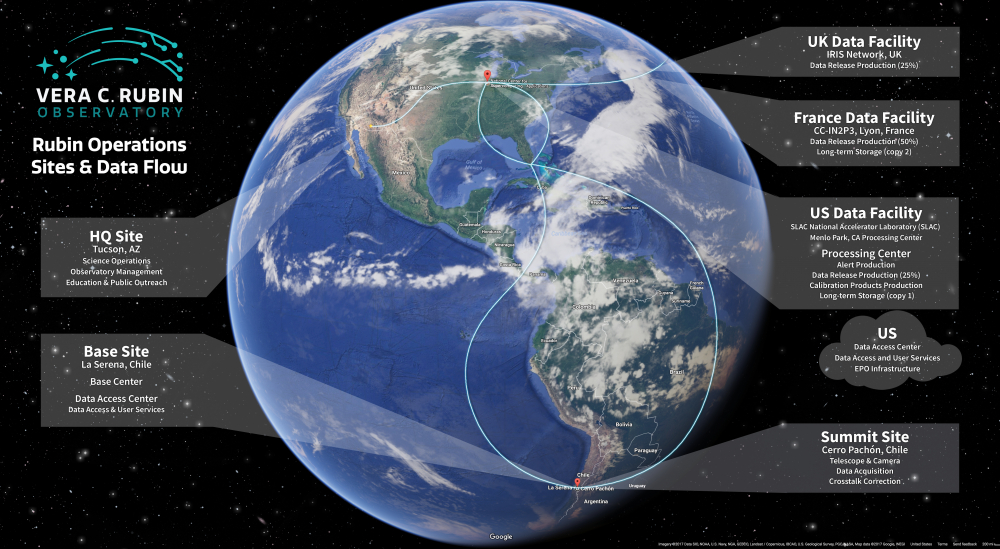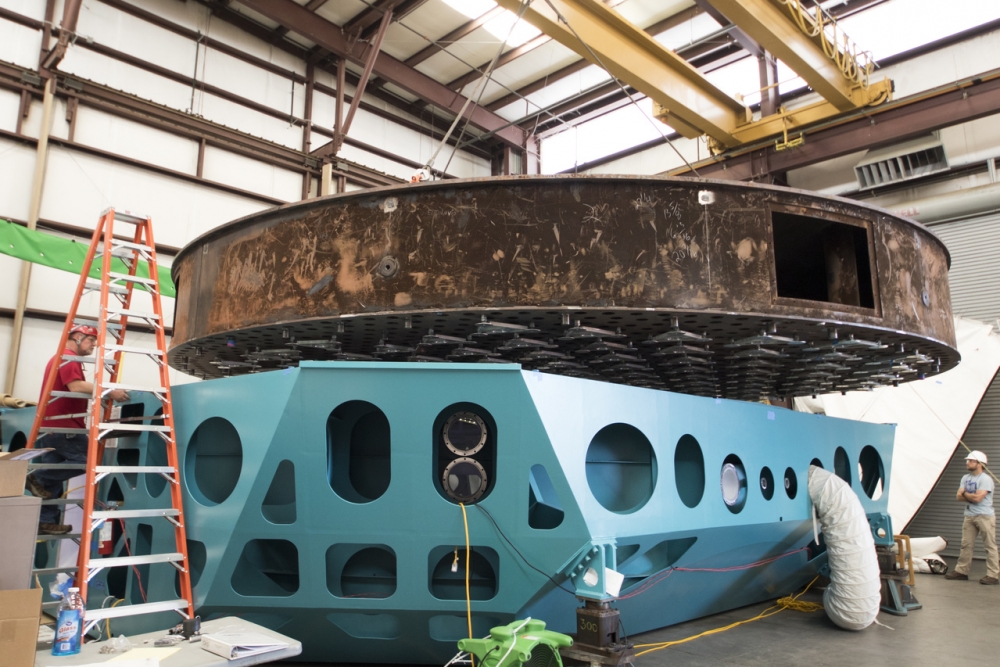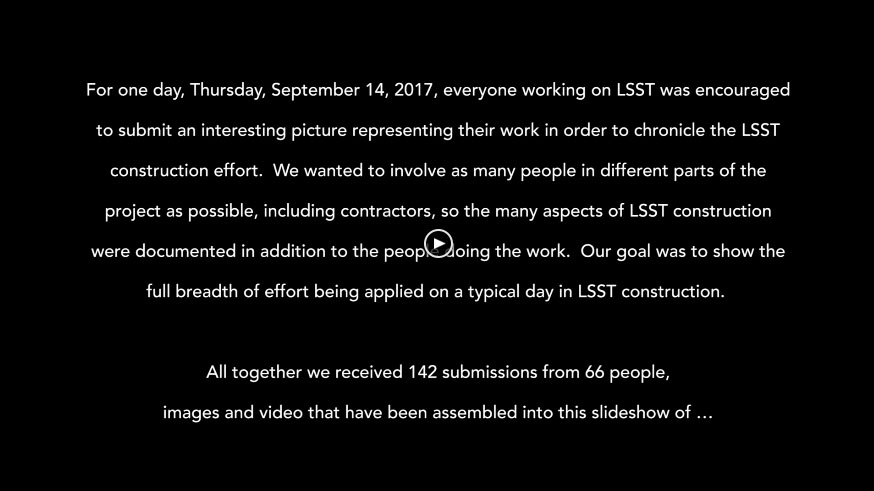A reminder: The LSST Town Hall at AAS 231 will take place on Wednesday, January 10th, 2018, at 7:30 pm. This Town Hall will include developments in the planning of LSST’s observing strategy and commissioning policies, and updates from the LSST Corporation and Science Collaborations on community preparations for science with LSST.
A successful LSST Safety Review, conducted by the Safety Council, took place in Chile on November 7-9, 2017. The focus of this review was to assess Chilean Base Facility and Summit Site safety processes. The presentations and tours demonstrated that safety has been effectively integrated into all levels of the Project, and that there is a high level of commitment to safety by LSST Project Management. Click here for a group photo from the event.
LSST’s fiber-optic network came one milestone closer to activation last week; the AURA LSST Dense Wavelength Division Multiplexing (DWDM) Network Equipment that LSST will use initially was installed in several key locations. More details about the installation are available in this recent news post.
New Tucson Scheduler Team members Tiago Ribeiro, Colin Winslow, and Andrew Heyer joined veteran members Francisco Delgado and Kem Cook for a face-to-face meeting with the Cadence Optimization Team in Seattle on November 13-16. The group laid out a detailed work plan for the development, testing, and use of the Scheduler until the end of Construction phase. View a photo of the meeting here.
Congratulations to LSST Systems Engineering Manager Brian Selvy, who was selected as one of the Tucson Hispanic Chamber of Commerce’s 2017 40 under 40. Brian will be honored at an awards breakfast on Tuesday, December 5. The complete list of winners and information about the awards event can be found here.
LSST enjoyed some positive media coverage on November 17 in this NPR story about the LSST Camera, featuring a tour of the SLAC LSST Camera clean room with SLAC physicist and LSST Camera Integration and Test subsystem scientist Aaron Roodman.
PERSONNEL NEWS
LSST welcomes Eric Morganson to the Data Management subsystem as Data Facility Production Scientist, based at the National Center for Supercomputing Applications (NCSA), beginning November 1. Eric will be responsible for integrating the production services for real-time processing and alert production, and will be the primary scientific liaison with the alert production pipeline developers at the University of Washington. Eric has been, and continues to be, a member of the DES data management project; in this capacity he is responsible for daily operations of the supernova transient detection pipeline.
Rigel Carlson joined the Systems Engineering subsystem as a student intern on November 14; Rigel attends the University of Arizona and is working towards a BS in Systems Engineering. Rigel will be providing assistance with a variety of Model Based Systems Engineering (MBSE) tasks using the MagicDraw modeling tool, including implementing approved change requests, documenting LSST methodologies, maintaining and updating the model organization, and integration of the legacy model into a single, cohesive model.
A new position with LSST is now available: Mechanical Integration Engineer with the Telescope and Site (T&S) team. This position will be based in La Serena and will be responsible for varied tasks to assist and coordinate assembly, integration, and verification activities (AIV) at the LSST summit site on Cerro Pachón as subsystems are delivered and integrated into the support building. More information on this and other open positions can be found on the LSST hiring website.
UPCOMING MEETINGS with LSST INVOLVEMENT
(those with asterisk* are LSSTC funded):
2017
|
|
|
November 30 -
December 1
|
AURA Workforce & Diversity Committee (WDC), Baltimore, MD
|
|
December 4-8
|
LSST/DESC 2017 Fall/Winter Sprint Week, Argonne National Laboratory, Lemont, IL*
|
|
December 4-8
|
LSST Workshop: Science Platform Detailed Design and Engineering Workshop, Pasadena, CA
|
|
December 5-7
|
Dual Agency Review of the Operations Proposal, Tucson, AZ
|
|
December 13-15
|
III Workshop LSST Chile: Towards Science in Chile with LSST, Santiago, Chile*
|
|
December 18-19
|
Project Science Team Meeting, Tucson, AZ
|
2018
|
|
|
January 8-12
|
American Astronomical Society (AAS) 231st Meeting, National Harbor, MD
|
|
January 10
|
LSST Town Hall at AAS 231, 7:30 pm
|
|
February 5
|
2018 DESC Meeting/Dark Energy School, SLAC, CA*
|
|
February 5-9
|
LSST-DESC Collaboration Meeting, SLAC, Menlo Park, CA*
|
|
March 5-9
|
Systems Engineering/Data Management Joint Technical Meeting, Pasadena, CA
|
|
April 18-20
|
Statistical Challenges for Large-scale Structure in the Era of LSST, Oxford, UK*
|
|
June 10-15
|
SPIE Astronomical Telescopes and Instrumentation Meeting, Austin, TX
|
|
June 11-15
|
LSST@Europe3, Lyon, France*
|
|
August 13-17
|
LSST Project and Community Workshop 2018, Tucson, AZ
|
NOTICIAS DEL PROYECTO Y CIENTIFICAS
Recordatorio: El LSST Town Hall, en AA231 tendrá lugar, el 10 de enero del 2018, a las 7:30 pm. Este Town Hall incluirá desarrollos en la planificación de la estrategia de observación y políticas de la puesta en marcha de LSST, y actualizaciones de la Corporación LSST y Colaboraciones Científicas en los preparativos de la comunidad para la ciencia con LSST.
Una exitosa Revisión de Seguridad de LSST, realizada por el Consejo de Seguridad, tuvo lugar en Chile del 7 al 9 de noviembre, 2017. El objetivo de esta revisión fue de evaluar los procesos de seguridad del Base Facility y sitio en Chile. Las presentaciones y las visitas guiadas demostraron que la seguridad se ha integrado efectivamente en todos los niveles del Proyecto, y que hay un gran nivel de compromiso con la seguridad por parte de la Gerencia de Proyectos de LSST. Hacer clic aquí para obtener una foto grupal del evento.
La red de Fibra Óptica de LSST se acercó aún más al hito de activación la semana pasada; el equipo de Red de Multiplexacion por División de Longitud de Ondas (DWDM) de AURA LSST que LSST usara inicialmente se instaló en varias ubicaciones clave. Más detalles sobre la instalación están disponibles en esta publicación reciente.
Los nuevos miembros del Equipo de Programación de Tucson, Tiago Ribeiro, Colin Winslow, y Andrew Heyer se unieron a los miembros veteranos Francisco Delgado y Kem Cook para una reunión cara a cara con el Equipo de Optimatización en Seattle del 13 al 16 de noviembre. El grupo presento un plan de trabajo detallado para el desarrollo, prueba y uso del Programador hasta el final de la fase de Construcción. Vea una foto de la reunión aquí.
Felicitaciones al Gerente de Ingeniería de Sistemas de LSST Brian Selvy, quien fue seleccionado como uno de los 40 menores de 40 años de la Cámara de Comercio Hispana de Tucson 2017. Brian será honrado en un desayuno de premiación el martes 5 de diciembre. La lista completa de ganadores e información sobre el evento se puede encontrar aquí.
LSST disfruto de una positiva cobertura mediática el 17 de noviembre en esta historia NPR sobre la Cámara de LSST, presentando un recorrido por la sala limpia de la cámara SLAC LSST con el Físico de SLAC y el Científico del Proyecto de LSST Aaron Roodman.
NOTICIAS DEL PERSONAL
LSST le da la bienvenida a Eric Morganson al Subsistema de Gestión de Datos como Científico de Producción de Instalaciones de Datos, con sede en el Centro Nacional de Aplicaciones de Supercomputación (NCSA), comenzando el 1 de noviembre. Eric será el responsable de integrar los servicios de producción para el procesamiento en tiempo real y la producción de alertas, y será el principal enlace Científico con los desarrolladores de tuberías de producción de alerta en la Universidad de Washington. Eric ha sido, y continuara siendo, un miembro del proyecto de gestión de datos DES; en esta capacidad, es responsable de las operaciones diarias de la tubería de detección de supernovas transitorias.
Rigel Carlson se unió al subsistema de Ingeniería de Sistemas como estudiante en práctica el 14 de noviembre; Rigel asiste a la Universidad de Arizona y está trabajando para obtener un BS en Ingeniería de Sistemas. Rigel brindara asistencia en una variedad de tareas de Ingeniería de Sistemas Basados en Modelos (MBSE) utilizando la herramienta de modelado MagicDraw, que incluye la implementación de solicitudes de cambio aprobadas, la documentación de metodologías de LSST, mantención y actualización de la organización modelo, e integración del modelo de legado en uno solo, modelo cohesivo.
Un nuevo puesto con LSST está ahora disponible: Ingeniero de Integración Mecánica con el equipo de Telescopio&Sitio. Este puesto estará basado en La Serena y será responsable de tareas variadas para asistir y coordinar las actividades de montaje, integración y verificación (AIV) en el sitio de LSST en Cerro Pachon a medida que los subsistemas se entreguen e integren al edificio de soporte. Se pueden encontrar más información de este y otros puestos de trabajo abiertos en el sitio web de contratación de LSST.
PROXIMAS REUNIONES con PARTICIPACION DE LSST
(aquellos con asterisco* son financiados por LSSTC):
2017
|
|
|
Noviembre 30 - Diciembre 1
|
Comite de Diversidad & Fuerza Laboral AURA (WDC), Baltimore, MD
|
|
Diciembre 4-8
|
LSST/DESC 2017 Fall/Winter Sprint Week, Argonne National Laboratory, Lemont, IL*
|
|
Diciembre 4-8
|
LSST Workshop: Taller de Diseño Detallado de la Plataforma Científica e Ingeniería. Pasadena, CA
|
|
Diciembre 5-7
|
Revisión de Agencia Dual de la Propuesta de Operaciones, Tucson, AZ
|
|
Diciembre 13-15
|
III Workshop LSST Chile: Hacia la Ciencia en Chile con LSST, Santiago, Chile*
|
|
Diciembre 18-19
|
Reunión del Equipo Científico del Proyecto, Tucson, AZ
|
2018
|
|
|
Enero 8-12
|
Reunión 231 de la American Astronomical Society (AAS), National Harbor, MD
|
|
Enero 10
|
LSST Town Hall at AAS 231, 7:30 pm
|
|
Febrero 5
|
2018 DESC Meeting/Dark Energy School, SLAC, CA*
|
|
Febrero 5-9
|
LSST-DESC Reunión de Colaboración, SLAC, Menlo Park, CA*
|
|
Marzo 5-9
|
Reunión en Conjunto Técnica Ingeniería de Sistemas/Gestión de Datos, Pasadena, CA
|
|
Abril 18-20
|
Desafíos Estadísticos de la Estructura a Gran Escala en la Era de LSST, Oxford, UK*
|
|
Junio 10-15
|
SPIE Reunión de Telescopios e Instrumentación Astronómica, Austin, TX
|
|
Junio 11-15
|
LSST@Europe3, Lyon, France*
|
|
Agosto 13-17
|
Taller de Proyecto y Comunitario LSST 2018, Tucson, AZ.
|


